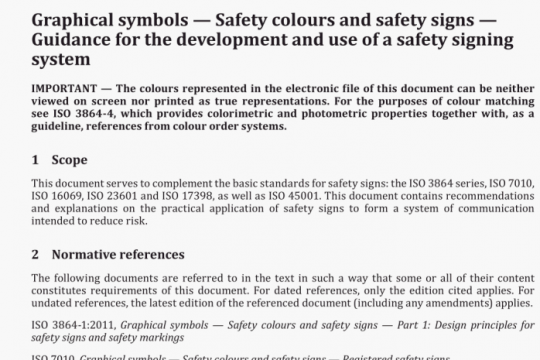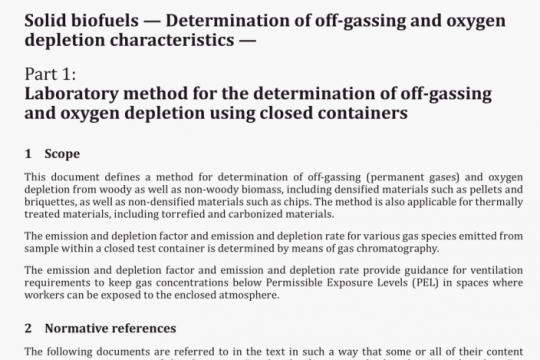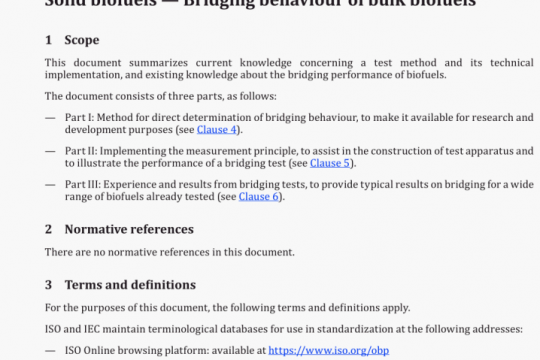ISO 10052 pdf free download
ISO 10052-2021 pdf free download.Acoustics一Field measurements of airborne and impact sound insulation and of service equipment sound一 Survey method.
5 Instrumentation
The measuring service equipment shall comply with the requirements ofClause 6.
The sound source for measuring sound insulation between rooms shall be as omnidirectional as practicable. In façade measurement, the opening angle shall cover the whole façade. The directivity of the sound source and the distance to the façade shall be such that the variations between pressure levels measured in front ofthe façade, for each frequency band ofinterest, are less than 5 dB.
The tapping machine shall comply with the requirements given in ISO 10140-5:2021, Annex E and ISO 16283-2:2020, Annex A. The heavy/soft impact source — rubber ball shall comply with the requirements given in ISO 10140-5:2021, Annex F and ISO 16283-2:2020, Annex A.
The accuracy ofthe sound pressure level measurement equipment shall comply with the requirements of accuracy classes 1 or 2 defined in LEC 61672-1. The complete measuring system including the microphone shall be adjusted before each measurement to enable absolute values of sound pressure levels to be obtained.
For all measurements diffuse field microphones are required. For sound level meters with free field microphones corrections for accounting the diffuse sound field shall be applied.
Filters shall comply with the requirements defined in IEC 61260.
NOTE For pattern evaluation (type testing) and regular verification tests recommended procedures for
sound level meters are given in OIML R58 and R88.
6 Test procedure and evaluation
6.1 General
The measurements of airborne sound insulation and of impact sound insulation are made in octave bands. The measurements of service equipment sound pressure levels are made in A-weighted or C-weighted sound pressure levels. The measurements shall be performed with doors and windows closed and shutters normally open. Operating cycles and operating conditions for measuring of service equipment noise shall be given in Annex B. They should only be used ifthey are not opposed to national requirements and regulations.
6.2 Generation ofsound field
6.2.1 General
lithe difference between the signal level and the background noise level is less than 6 dB, the measured signal level shall be recorded in the report. A note shall be added to say that the measured receiving room level was affected by background noise and the corresponding level difference has been underestimated or that the measurement level (service equipment) has been overestimated by an unknown amount.
No correction for background noise shall be applied.
For measurements ofthe airborne sound insulation between rooms and the airborne sound insulation of façades using the loudspeaker method, the sound power of the source should be adjusted so that the sound pressure level in the receiving room (in each frequency band) is at least 6 dB higher than the background noise level. This shall be checked by switching the source on and off before starting the measurement.
When measuring the airborne sound insulation of façades by the traffic sound method, the background noise level in the receiving room cannot easily be assessed. Because of this, steps should be taken to ensure that the noise level in the receiving room due to sources within the building is as low as practicable. Excessive background noise from internal sources will lead to an underestimate of the façade insulation. A comment shall be made in the report ifthis is thought to have occurred.
6.2.2 Airborne sound insulation between rooms
The sound generated in the source room shall be steady and have a continuous spectrum in the frequency range considered. Filters with a bandwidth of one octave may be used. When using broad- band noise, the spectrum of the sound source may be shaped to ensure an adequate signal-to-noise ratio at high frequencies in the receiving room.
If the sound source enclosure contains more than one loudspeaker operating simultaneously, the loudspeakers shall be driven in phase. Multiple sound sources may be used simultaneously providing they are of the same type and are driven at the same level by similar, but uncorrelated, signals.
Place the sound source in a corner of the room opposite the separating element. The distance from the walls shall be at least 0,5 m. If the source is a single loudspeaker system it should be placed facing the Corner.
When testing rooms in a vertical direction, use the lower room as the source room. When testing rooms of unequal size in a horizontal direction, use the larger room as the source room unless it has been previously agreed that the test should be in the other direction.
6.2.3 Impact sound insulation between rooms
The impact sound shall be generated by the standard tapping machine and/or rubber ball (see ISO 10140-5 and ISO 16283-2). The standard impact sound sources; tapping machine and rubber ball, shall be placed in the source room near the centre of the floor (in case of tapping machine on the diagonal direction). This single position is sufficient if the floor and slab are isotropic.
NOTE In complex cases, see numerous examples of room arrangements and measurement positions in ISO 16283-2:2020, Annex E.
In the case of anisotropic floor constructions (with ribs, beams, etc.) add two positions so that the three positions are randomly distributed over the floor area. The hammer connecting line should be orientated at 45° to the direction of the beams or ribs. In these cases, the distance of the tapping machine from the edges of the floor shall be at least 0,5 m.
6.2.4 Airborne sound insulation of façades
The airborne sound insulation of façades is measured using an outside loudspeaker or road traffic sound. The room behind the façade serves as the receiving room.ISO 10052 pdf download.




